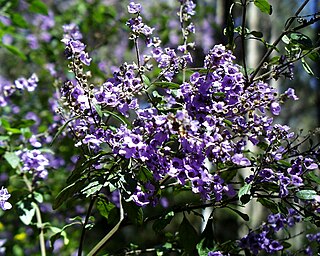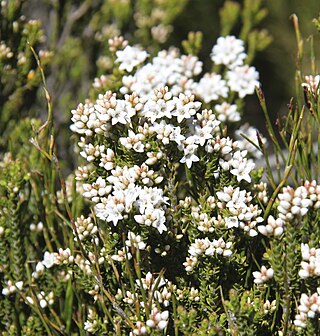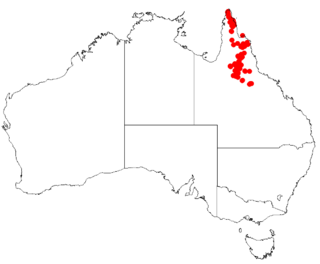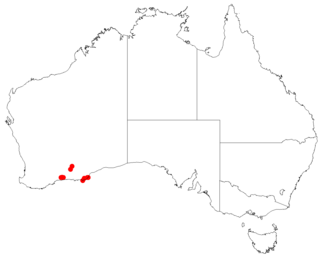
Olearia teretifolia, commonly known as cypress daisy-bush, is a species of flowering plant in the family Asteraceae and is endemic to south-eastern continental Australia. It is a slender, erect to spreading shrub with more or less sessile, linear leaves pressed against the stem, and white and yellow, daisy-like inflorescences.

Prostanthera melissifolia, commonly known as balm mint bush, is a species of flowering plant in the family Lamiaceae and is endemic to south-eastern Australia. It is an erect shrub with hairy branches, egg-shaped leaves with fine teeth on the edges and mauve to purple or pink flowers on the ends of branchlets.

Phebalium nottii, commonly known as pink phebalium, is a species of shrub that is endemic to eastern Australia. It has branchlets with silvery scales, oblong to elliptical leaves, deep pink to mauve flowers arranged in umbels of up to six, with the stamens distinctively offset to one side of the flower.

Epacris glacialis, commonly known as reddish bog-heath, is a species of flowering plant in the family Ericaceae and is endemic to south-eastern continental Australia. It is a prostrate to low-lying shrub with crowded, rhombus-shaped to broadly egg-shaped leaves with the narrower end towards the base, and tube-shaped, white flowers in small clusters near the ends of the branches.

Prostanthera phylicifolia, commonly known as spiked mint-bush, is a species of plant in the family Lamiaceae. It is an erect shrub with four-ridged branches, narrow egg-shaped to oval leaves and white or pale lilac-coloured flowers with purple and yellow spots.
Grevillea angustiloba, commonly known as dissected holly-leaf grevillea, is a species of flowering plant in the family Proteaceae and is endemic to southern continental Australia. It is a prostrate, low-lying or erect shrub with deeply divided pinnate leaves and usually red, sometimes orange or pale yellow flowers.

Prostanthera decussata, commonly known as dense mintbush, species of flowering plant that is endemic south-eastern Australia. It is a dense, compact, strongly aromatic shrub with egg-shaped leaves and mauve to violet flowers with yellow streaks, arranged in leaf axils near the ends of branchlets.

Grevillea oligantha is a species of flowering plant in the family Proteaceae and is endemic to southern Western Australia. It is dense shrub with many erect branches, egg-shaped, lance-shaped or linear leaves, and groups of up to six brownish-yellow, orange or reddish-brown flowers with a pale yellow to reddish style.
Thryptomene elliottii is a species of flowering plant in the family Myrtaceae and is endemic to southern central Australia. It is a shrub with decussate, egg-shaped to club-shaped leaves and pink or white flowers with five petals and five stamens.

Boronia bowmanii is a plant in the citrus family, Rutaceae and is endemic to Queensland. It is an erect shrub with pinnate leaves and four-petalled flowers.

Prostanthera canaliculata is a species of flowering plant in the family Lamiaceae and is endemic to the south-west of Western Australia. It is a small, erect shrub with hairy branchlets, narrow egg-shaped to narrow elliptical leaves and pale blue or pale violet to white flowers with no markings.

Commersonia craurophylla, commonly known as brittle leaved rulingia, is a species of flowering plant in the family Malvaceae and endemic to southern continental Australia. It is a dense, spreading shrub with crinkled, narrowly oblong to linear leaves, and white to cream-coloured flowers.
Thryptomene ericaea is a species of flowering plant in the family Myrtaceae and is endemic to South Australia. It is a shrub with narrow elliptic leaves and white flowers with five petals and five stamens.

Hibbertia desmophylla is a species of flowering plant in the family Dilleniaceae and is endemic to the south-west of Western Australia. It is a sprawling or erect, hairy shrub with spreading, densely clustered, linear leaves and yellow flowers with eleven to thirteen stamens.

Bossiaea neoanglica is a species of flowering plant in the family Fabaceae and is endemic to eastern Australia. It is a prostrate to low-lying shrub with sparsely hairy foliage, egg-shaped to more or less round leaves, and yellow and red flowers.

Lasiopetalum oldfieldii is a species of flowering plant in the family Malvaceae and is endemic to the south-west of Western Australia. It is a low, spreading shrub with rusty-hairy young stems, egg-shaped to narrowly egg-shaped leaves and pink and dark red flowers.

Leucopogon bossiaea is a species of flowering plant in the heath family Ericaceae and is endemic to a restricted area in the south-west of Western Australia. It is an erect shrub with elliptic to broadly egg-shaped leaves and white flowers in four to eleven upper leaf axils.

Cryptandra longistaminea is a species of flowering plant in the family Rhamnaceae and is endemic to eastern Australia. It is a shrub with many branches, egg-shaped or elliptic to linear leaves, and clusters of white, tube-shaped flowers.

Commersonia magniflora is a species of flowering plant in the family Malvaceae and endemic to Australia. It is an erect shrub with wrinkled, narrowly oblong to elliptic or egg-shaped leaves, and deep pink flowers.

Androcalva melanopetala is a species of flowering plant in the family Malvaceae and is endemic to southern inland Western Australia. It is a sometimes prostrate shrub that has densely hairy new growth, egg-shaped to elliptic leaves with rounded teeth on the edges, and clusters of white or cream-coloured and pink to red flowers.


















